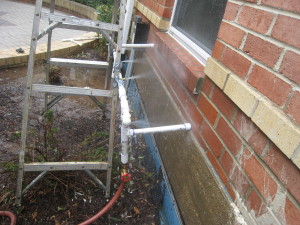Spray Water Test

 Spray Water Testing is often used to evaluate water leakage of buildings, especially at walls, windows or doors. Although there are many ways to determine if something is watertight, a common and effective field test incorporates two types of wet conditions that a building will encounter during a storm: surface flow and wind-driven rain.
Spray Water Testing is often used to evaluate water leakage of buildings, especially at walls, windows or doors. Although there are many ways to determine if something is watertight, a common and effective field test incorporates two types of wet conditions that a building will encounter during a storm: surface flow and wind-driven rain.
Surface Flow refers to water that flows down the face of a wall due to gravity. This type of flow can cause leaks without the pressure difference that comes along with the wind of a storm. To simulate it, a section of wall is isolated and sprayed with a spray nozzle at flow rates specified by ASTM E2128.
To test the window/wall for wind-driven rain, a pressure chamber is used. This chamber is usually on the inside of the building and a vacuum is placed in the chamber which draws water into the building to generate “wind” (AAMA 511). A spray rack is then used to simulate rain during a storm (see AAMA 502).
These tests are generally judged to PASS or FAIL for the window and/or wall in question. However, we can make the process more diagnostic by isolating a smaller defective section of the wall. This is helpful in determining the necessary repairs because a section of the wall, or a joint of a window may be all that needs to be repaired or replaced instead of the entire wall/window.
A recent ETC investigation of a water leak in an office space utilized a less involved test in which a garden hose and nozzle were used to systemically spray different potential leak areas until the location of the water entry point was discovered. By starting at the lowest elevation and working up, you can eliminate uncertainty about where the leak really is.



